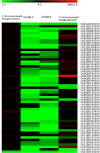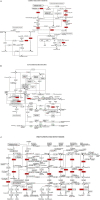Molecular Programming of Drought-Challenged Trichoderma harzianum-Bioprimed Rice (Oryza sativa L.)
- PMID: 33927706
- PMCID: PMC8076752
- DOI: 10.3389/fmicb.2021.655165
Molecular Programming of Drought-Challenged Trichoderma harzianum-Bioprimed Rice (Oryza sativa L.)
Abstract
Trichoderma biopriming enhances rice growth in drought-stressed soils by triggering various plant metabolic pathways related to antioxidative defense, secondary metabolites, and hormonal upregulation. In the present study, transcriptomic analysis of rice cultivar IR64 bioprimed with Trichoderma harzianum under drought stress was carried out in comparison with drought-stressed samples using next-generation sequencing techniques. Out of the 2,506 significant (p < 0.05) differentially expressed genes (DEGs), 337 (15%) were exclusively expressed in drought-stressed plants, 382 (15%) were expressed in T. harzianum-treated drought-stressed plants, and 1,787 (70%) were commonly expressed. Furthermore, comparative analysis of upregulated and downregulated genes under stressed conditions showed that 1,053 genes (42%) were upregulated and 733 genes (29%) were downregulated in T. harzianum-treated drought-stressed rice plants. The genes exclusively expressed in T. harzianum-treated drought-stressed plants were mostly photosynthetic and antioxidative such as plastocyanin, small chain of Rubisco, PSI subunit Q, PSII subunit PSBY, osmoproteins, proline-rich protein, aquaporins, stress-enhanced proteins, and chaperonins. The Kyoto Encyclopedia of Genes and Genomes (KEGG) enrichment analysis states that the most enriched pathways were metabolic (38%) followed by pathways involved in the synthesis of secondary metabolites (25%), carbon metabolism (6%), phenyl propanoid (7%), and glutathione metabolism (3%). Some of the genes were selected for validation using real-time PCR which showed consistent expression as RNA-Seq data. Furthermore, to establish host-T. harzianum interaction, transcriptome analysis of Trichoderma was also carried out. The Gene Ontology (GO) analysis of T. harzianum transcriptome suggested that the annotated genes are functionally related to carbohydrate binding module, glycoside hydrolase, GMC oxidoreductase, and trehalase and were mainly upregulated, playing an important role in establishing the mycelia colonization of rice roots and its growth. Overall, it can be concluded that T. harzianum biopriming delays drought stress in rice cultivars by a multitude of molecular programming.
Keywords: DEGs; Trichoderma harzianum; drought; rice; transcriptome (RNA-seq).
Copyright © 2021 Bashyal, Parmar, Zaidi and Aggarwal.
Conflict of interest statement
The authors declare that the research was conducted in the absence of any commercial or financial relationships that could be construed as a potential conflict of interest.
Figures







Similar articles
-
Dose-dependent response of Trichoderma harzianum in improving drought tolerance in rice genotypes.Planta. 2016 May;243(5):1251-64. doi: 10.1007/s00425-016-2482-x. Epub 2016 Feb 22. Planta. 2016. PMID: 26898554
-
Biochemical and physiological responses of rice (Oryza sativa L.) as influenced by Trichoderma harzianum under drought stress.Plant Physiol Biochem. 2012 May;54:78-88. doi: 10.1016/j.plaphy.2012.02.001. Epub 2012 Feb 8. Plant Physiol Biochem. 2012. PMID: 22391125
-
Iris lactea var. chinensis plant drought tolerance depends on the response of proline metabolism, transcription factors, transporters and the ROS-scavenging system.BMC Plant Biol. 2023 Jan 9;23(1):17. doi: 10.1186/s12870-022-04019-4. BMC Plant Biol. 2023. PMID: 36617566 Free PMC article.
-
Unearth of small open reading frames (sORFs) in drought stress transcriptome of Oryza sativa subsp. indica.Gene. 2023 Aug 20;878:147579. doi: 10.1016/j.gene.2023.147579. Epub 2023 Jun 17. Gene. 2023. PMID: 37336274
-
Plant growth promotion and differential expression of defense genes in chilli pepper against Colletotrichum truncatum induced by Trichoderma asperellum and T. harzianum.BMC Microbiol. 2023 Mar 3;23(1):54. doi: 10.1186/s12866-023-02789-x. BMC Microbiol. 2023. PMID: 36864373 Free PMC article.
Cited by
-
Microbial Contributions for Rice Production: From Conventional Crop Management to the Use of 'Omics' Technologies.Int J Mol Sci. 2022 Jan 10;23(2):737. doi: 10.3390/ijms23020737. Int J Mol Sci. 2022. PMID: 35054923 Free PMC article. Review.
-
Enhancing wheat resilience to salinity: the role of endophytic Penicillium chrysogenum as a biological agent for improved crop performance.BMC Plant Biol. 2025 Mar 19;25(1):354. doi: 10.1186/s12870-025-06388-y. BMC Plant Biol. 2025. PMID: 40102779 Free PMC article.
-
Spectroscopic Investigation of Tomato Seed Germination Stimulated by Trichoderma spp.Biology (Basel). 2024 May 13;13(5):340. doi: 10.3390/biology13050340. Biology (Basel). 2024. PMID: 38785822 Free PMC article.
-
Seed Bio-priming of wheat with a novel bacterial strain to modulate drought stress in Daegu, South Korea.Front Plant Sci. 2023 Apr 27;14:1118941. doi: 10.3389/fpls.2023.1118941. eCollection 2023. Front Plant Sci. 2023. PMID: 37180396 Free PMC article.
-
Trichoderma spp.-mediated mitigation of heat, drought, and their combination on the Arabidopsis thaliana holobiont: a metabolomics and metabarcoding approach.Front Plant Sci. 2023 Aug 21;14:1190304. doi: 10.3389/fpls.2023.1190304. eCollection 2023. Front Plant Sci. 2023. PMID: 37692426 Free PMC article.
References
-
- Alwhibi M. S., Hashem A., Fathi E., Allah A., Alqarawi A. A., Soliman D. W. K., et al. (2017). Increased resistance of drought by Trichoderma harzianum fungal treatment correlates with increased secondary metabolites and proline content. J. Integ. Agric. 16 1751–1757. 10.1016/S2095-3119(17)61695-2 - DOI
-
- Azarmi R., Hajieghrari B., Giglou A. (2011). Effect of Trichoderma isolates on tomato seedling growth response and nutrient uptake. Afric. J. Biotechnol. 10 5850–5855. 10.5897/AJB10.1600 - DOI
LinkOut - more resources
Full Text Sources
Other Literature Sources

